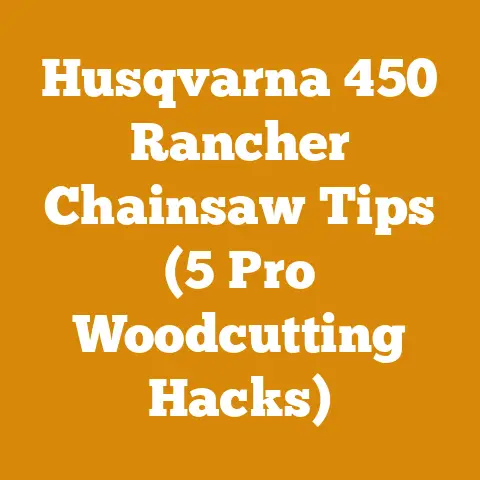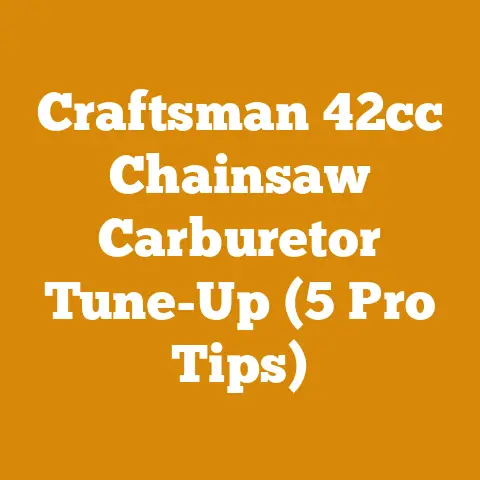Face Shields for Weed Eating (Essential PPE Tips for Wood Pros)
The sting of flying debris! It’s a challenge I’ve faced countless times while weed eating, and it’s a challenge that highlights the critical need for proper personal protective equipment (PPE). As wood pros, we’re accustomed to dealing with powerful equipment and potential hazards, but complacency can lead to serious injury. This article dives deep into the importance of face shields for weed eating, not just as a recommended safety measure, but as an essential component of your PPE arsenal. We’ll explore the “why” behind face shields, the types available, and how to choose the right one for your specific needs. Furthermore, we’ll delve into other crucial PPE tips that will keep you safe and productive in the field. Let’s get started.
Face Shields for Weed Eating: Essential PPE Tips for Wood Pros
Weed eating might seem like a relatively low-risk task compared to felling trees or bucking logs, but the potential for injury is very real. Flying rocks, bits of wire, plant matter, and even insects can be propelled at high speed towards your face. A face shield provides a crucial barrier against these hazards, protecting your eyes, nose, and mouth from potential damage. It’s not just about avoiding discomfort; it’s about preventing serious injuries that could sideline you from work and impact your livelihood.
Why a Face Shield?
Think of your face shield as your first line of defense. While safety glasses offer some protection, they leave a significant portion of your face exposed. A face shield extends that protection, covering a wider area and deflecting larger debris. It’s an investment in your well-being and your ability to continue working safely and productively.
Types of Face Shields for Weed Eating
Choosing the right face shield is crucial. They aren’t all created equal. Here’s a breakdown of common types and their suitability for weed eating:
-
Mesh Face Shields: These offer excellent ventilation, which is a huge plus on hot days. However, they don’t provide complete protection against very small particles. I often use these for lighter weed eating tasks where the risk of small debris is low.
-
Clear Polycarbonate Face Shields: These offer superior impact resistance and protection against a wider range of debris, including small particles. They can fog up in humid conditions, so look for models with anti-fog coatings. These are my go-to for most weed eating jobs.
-
Tinted Face Shields: These are great for sunny days, reducing glare and eye strain. However, be careful using them in low-light conditions, as they can reduce visibility.
Choosing the Right Face Shield
Here are some factors to consider when choosing a face shield:
-
Impact Resistance: Look for face shields that meet ANSI Z87.1 standards for impact resistance. This certification ensures that the shield can withstand high-velocity impacts.
-
Coverage Area: Choose a face shield that provides adequate coverage for your entire face, including your forehead, cheeks, and chin.
-
Visibility: Ensure that the face shield offers clear visibility without distortion. Avoid models with scratches or blemishes that could impair your vision.
-
Comfort: Look for a face shield that is comfortable to wear for extended periods. Consider features like adjustable headbands and padded brow guards.
-
Anti-Fog Coating: If you live in a humid climate, choose a face shield with an anti-fog coating to prevent condensation from obscuring your vision.
My Personal Experience
I remember one time I was weed eating around a brush pile. I was wearing safety glasses, but not a face shield. A piece of wire flung up from the trimmer and struck me just below my eye. Luckily, it only resulted in a minor scratch, but it could have been much worse. That experience taught me a valuable lesson about the importance of full facial protection. Now, I never weed eat without a face shield.
1. Head Protection: Hard Hats and Safety Helmets
Definition: A hard hat or safety helmet is a rigid protective covering for the head, designed to protect against impacts, falling objects, and electrical hazards.
Why It’s Important: Working in the woods exposes you to numerous head injury risks, from falling branches to swinging logs. A hard hat can literally be a lifesaver.
How to Interpret It: A properly fitted hard hat should sit comfortably on your head without being too tight or too loose. The suspension system should be adjusted to provide a snug and secure fit. Regularly inspect your hard hat for cracks, dents, or other damage. Replace it immediately if you notice any signs of wear and tear.
How It Relates to Other Metrics: Head injuries can lead to significant downtime and medical expenses. Investing in a high-quality hard hat is a small price to pay for preventing serious injury and maintaining productivity.
Practical Example: I once witnessed a logger who wasn’t wearing a hard hat get struck by a falling branch. He suffered a concussion and was out of work for several weeks. That incident reinforced the importance of always wearing a hard hat, no matter how quick the task.
2. Eye Protection: Safety Glasses and Goggles
Definition: Safety glasses and goggles are protective eyewear designed to shield the eyes from impacts, dust, debris, and chemical splashes.
Why It’s Important: The eyes are incredibly vulnerable to injury in the wood processing environment. Flying debris, sawdust, and chemical splashes can cause serious damage.
How to Interpret It: Choose safety glasses or goggles that fit snugly and comfortably, providing full coverage of the eyes. Look for models that meet ANSI Z87.1 standards for impact resistance. Consider the specific hazards you’ll be facing. For example, if you’re working with chemicals, you’ll need goggles that provide splash protection.
How It Relates to Other Metrics: Eye injuries can result in permanent vision loss and significant medical costs. Proper eye protection is a simple and effective way to prevent these injuries.
Practical Example: I always wear safety glasses when using a chainsaw, even for quick cuts. Sawdust and wood chips can easily get into your eyes, causing irritation and potential injury.
3. Hearing Protection: Earplugs and Earmuffs
Definition: Earplugs and earmuffs are devices designed to reduce the level of noise exposure, protecting the ears from damage.
Why It’s Important: Prolonged exposure to loud noise can cause permanent hearing loss. Chainsaws, wood chippers, and other power tools generate high levels of noise that can damage your hearing over time.
How to Interpret It: Choose earplugs or earmuffs that provide adequate noise reduction for the specific noise levels you’ll be exposed to. Look for models with a Noise Reduction Rating (NRR) of at least 25 decibels. Ensure that earplugs fit snugly and comfortably in your ear canals. Earmuffs should fit snugly over your ears, creating a tight seal.
How It Relates to Other Metrics: Hearing loss can negatively impact your ability to communicate and work effectively. It can also lead to long-term health problems. Investing in good hearing protection is essential for preserving your hearing and maintaining your overall well-being.
Practical Example: I use earmuffs with a built-in radio when I’m operating a chainsaw for extended periods. This allows me to protect my hearing while still being able to listen to music or podcasts.
4. Hand Protection: Work Gloves
Definition: Work gloves are protective coverings for the hands, designed to protect against cuts, abrasions, impacts, and chemical exposure.
Why It’s Important: The hands are constantly exposed to hazards in the wood processing environment. Sharp tools, rough materials, and chemicals can cause cuts, abrasions, and burns.
How to Interpret It: Choose work gloves that are appropriate for the specific tasks you’ll be performing. Leather gloves are a good all-around choice for general work. Cut-resistant gloves are essential when using sharp tools like chainsaws and knives. Chemical-resistant gloves are necessary when handling chemicals.
How It Relates to Other Metrics: Hand injuries can significantly impact your ability to work and perform daily tasks. Proper hand protection is essential for preventing these injuries and maintaining your productivity.
Practical Example: I always wear cut-resistant gloves when sharpening my chainsaw. A slip of the file can easily result in a deep cut.
5. Foot Protection: Safety Boots
Definition: Safety boots are protective footwear designed to protect the feet from impacts, punctures, and slips.
Why It’s Important: The feet are vulnerable to injury from falling objects, sharp objects, and slippery surfaces. Safety boots provide essential protection against these hazards.
How to Interpret It: Choose safety boots that meet ANSI Z41 standards for impact and compression resistance. Look for models with steel toes and slip-resistant soles. Ensure that the boots fit comfortably and provide adequate support.
How It Relates to Other Metrics: Foot injuries can limit your mobility and ability to work. Proper foot protection is essential for preventing these injuries and maintaining your productivity.
Practical Example: I always wear safety boots with ankle support when working in the woods. Uneven terrain can easily lead to sprains and ankle injuries.
6. Leg Protection: Chainsaw Chaps or Trousers
Definition: Chainsaw chaps or trousers are protective clothing worn over the legs to protect against chainsaw cuts.
Why It’s Important: Chainsaws are incredibly powerful tools that can cause serious injury if they come into contact with your legs. Chainsaw chaps or trousers are designed to stop the chain almost instantly, preventing or minimizing injury.
How to Interpret It: Choose chainsaw chaps or trousers that meet ASTM F1897 standards for chainsaw leg protection. Ensure that they fit properly and provide adequate coverage for your legs.
How It Relates to Other Metrics: Chainsaw injuries can be life-threatening. Chainsaw chaps or trousers are an essential piece of PPE for anyone operating a chainsaw.
Practical Example: I always wear chainsaw chaps when felling trees or bucking logs. Even experienced chainsaw operators can make mistakes, and chainsaw chaps can be the difference between a minor scratch and a serious injury.
7. Respiratory Protection: Dust Masks and Respirators
Definition: Dust masks and respirators are devices designed to protect the lungs from inhaling dust, fumes, and other airborne particles.
Why It’s Important: Sawdust, wood smoke, and other airborne particles can irritate the lungs and cause respiratory problems. Prolonged exposure can lead to chronic respiratory illnesses.
How It Relates to Other Metrics: Respiratory problems can impact your ability to work and perform daily tasks. Proper respiratory protection is essential for preserving your lung health and maintaining your overall well-being.
Practical Example: I always wear a dust mask when sanding wood or operating a wood chipper. These activities generate a lot of dust that can irritate my lungs.
8. High-Visibility Clothing
Definition: High-visibility clothing is clothing that is designed to be easily seen, especially in low-light conditions.
Why It’s Important: Working in the woods can be dangerous, especially if you’re working near roads or other traffic. High-visibility clothing makes you more visible to other workers, drivers, and pedestrians, reducing the risk of accidents.
How to Interpret It: Choose high-visibility clothing that meets ANSI/ISEA 107 standards for high-visibility safety apparel. Look for clothing that is brightly colored and has reflective stripes.
How It Relates to Other Metrics: Accidents involving vehicles or other equipment can result in serious injuries or fatalities. High-visibility clothing is a simple and effective way to reduce the risk of these accidents.
Practical Example: I always wear a high-visibility vest when working near roads or operating heavy equipment.
Maintaining Your PPE: A Key to Longevity and Safety
Having the right PPE is only half the battle. Proper maintenance is critical to ensuring that your equipment remains effective and safe. Here are some tips for maintaining your PPE:
-
Regular Inspection: Inspect your PPE before each use for any signs of damage or wear and tear. Replace any damaged or worn items immediately.
-
Cleaning: Clean your PPE regularly according to the manufacturer’s instructions. This will help to remove dirt, debris, and other contaminants that can reduce its effectiveness.
-
Storage: Store your PPE in a clean, dry place when not in use. This will help to protect it from damage and extend its lifespan.
-
Replacement: Replace your PPE according to the manufacturer’s recommendations. Even if your PPE appears to be in good condition, it may lose its effectiveness over time.
The Cost of PPE vs. the Cost of Injury
It’s tempting to cut corners on PPE, especially when budgets are tight. However, the cost of PPE is negligible compared to the cost of an injury. Even a minor injury can result in lost work time, medical expenses, and pain and suffering. A serious injury can have devastating consequences, including permanent disability or even death.
Investing in high-quality PPE and maintaining it properly is an investment in your safety and well-being. It’s a small price to pay for peace of mind and the ability to continue working safely and productively.
Applying These Tips to Improve Future Projects
The key to improving future wood processing and firewood preparation projects lies in learning from past experiences and continuously refining your safety practices. Here’s how you can apply the PPE tips discussed in this article to achieve that:
-
Conduct a thorough risk assessment: Before starting any project, take the time to identify potential hazards and assess the risks involved. This will help you determine the appropriate PPE for the job. I always walk the site and think through each step of the process.
-
Develop a PPE plan: Based on your risk assessment, create a detailed PPE plan that outlines the specific PPE required for each task. Share this plan with all workers involved in the project. Make sure everyone understands the plan.
-
Monitor PPE compliance: Regularly monitor workers to ensure that they are complying with the PPE plan. Address any non-compliance issues immediately. Don’t be afraid to call someone out for not wearing their PPE properly. It could save their life.
-
Review and update your PPE plan: Review your PPE plan regularly and update it as needed to reflect changes in work practices, equipment, or environmental conditions. We learn something new on almost every project, so updating the plan is essential.
By implementing these strategies, you can create a safer and more productive work environment for yourself and your team. Remember, safety is not just a priority; it’s a value. By prioritizing safety in everything you do, you can protect yourself from injury and ensure the long-term success of your wood processing and firewood preparation projects.






